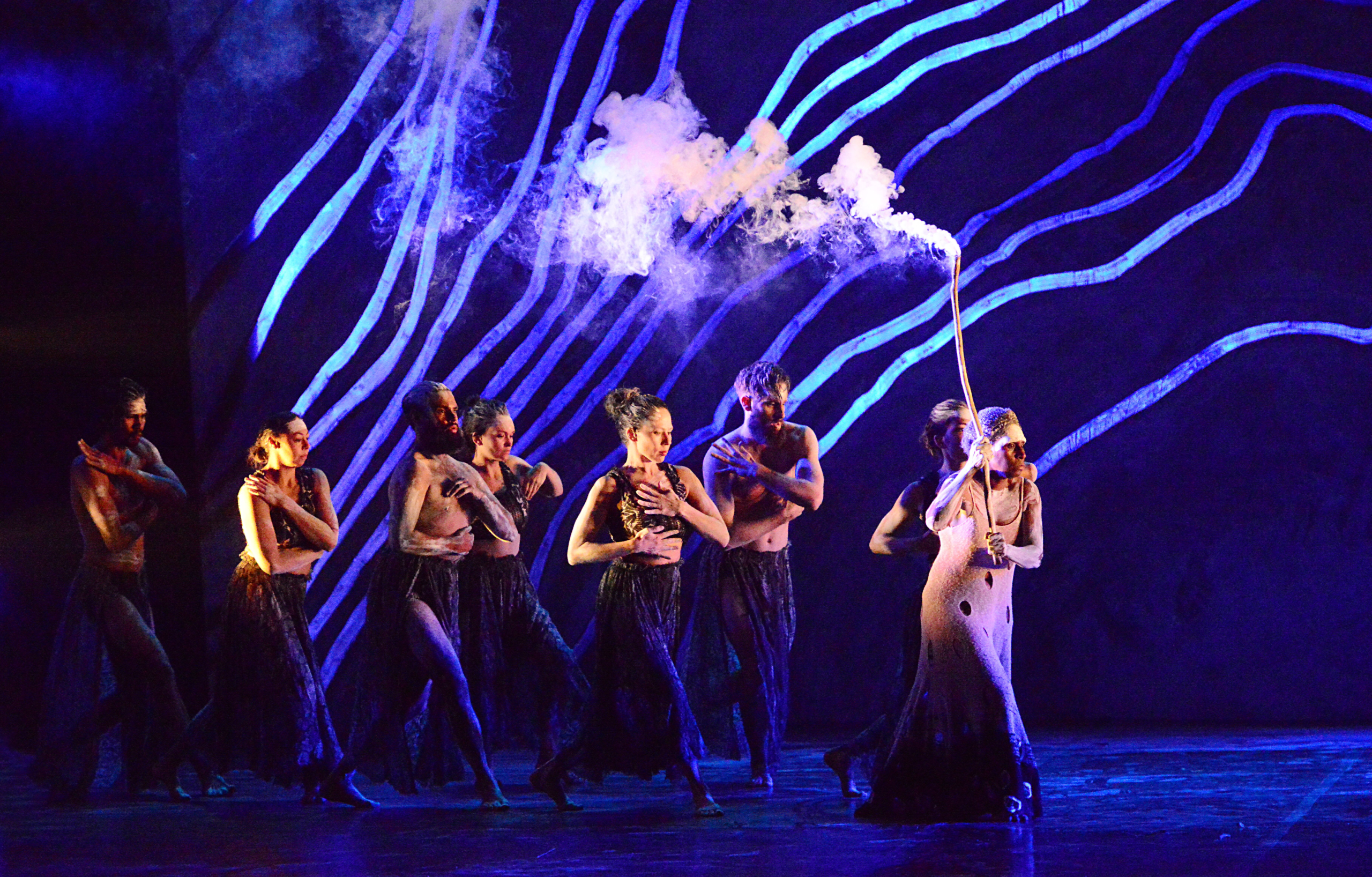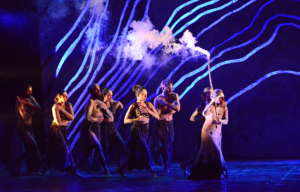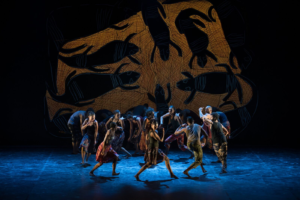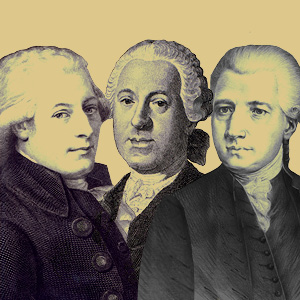
 [rating=4]The power of art to transport, to whisk us away, to take us outside of ourselves for a while, on a journey – possibly to another land, another world, another time – is a magical thing. It can be something as simple as gazing at the portrayal of a Santa Fe sunset, flaming streaks of crimson, tangerine and saffron mingling with and melding into the inky echoes of indigo and plum as night descends, that can wondrously ferry you to the sandstone bluffs of New Mexico. Or maybe, it’s listening to a symphonic performance of Beethoven’s 9th, the lustrous tones of the strings, interwoven with the whistle of the woodwinds, merging with the bright blaring of the horns, all punctuated by the pounding of drums and crashing of cymbals, that propels you across oceans to a concert hall in Vienna.
[rating=4]The power of art to transport, to whisk us away, to take us outside of ourselves for a while, on a journey – possibly to another land, another world, another time – is a magical thing. It can be something as simple as gazing at the portrayal of a Santa Fe sunset, flaming streaks of crimson, tangerine and saffron mingling with and melding into the inky echoes of indigo and plum as night descends, that can wondrously ferry you to the sandstone bluffs of New Mexico. Or maybe, it’s listening to a symphonic performance of Beethoven’s 9th, the lustrous tones of the strings, interwoven with the whistle of the woodwinds, merging with the bright blaring of the horns, all punctuated by the pounding of drums and crashing of cymbals, that propels you across oceans to a concert hall in Vienna.
These encounters with the artistic world give us a chance to experience, for a brief time, a reality not our own, and often we learn and grow as a result. Occasionally, we have the good fortune to witness a work of art so masterful in its composition and profound in its message, that it does more than just transport us to another place, it touches something deep within our souls and we are irrevocably altered as a result. Such was the case last evening, when I was introduced to the magical, artistic alchemy that is Bangarra Dance Theatre Australia, at the Harris Theater for Music and Dance on East Randolph, as they performed two works, Spirit and Nyapanyapa, in their Chicago debut.
One of Australia’s leading performing arts companies, Bangarra Dance Theatre Australia is an Aboriginal and Torres Strait Islander organization, world renowned for its distinctive dance language, immersive soundscapes, spectacular music and costumes, and exquisite design. Each company member is of Aboriginal and/or Torre Straight Islander descent, and every work developed and performed draws on stories from respected community elders, gleaned from more than 65,000 years of Australian culture and civilization. All of this comes together to create an artistic performance that fuses spirit and dance in a program of remarkable strength and stunning beauty, that pushes the limits of physicality and acts as a bridge between the traditional and the contemporary.
The first performance of the evening, entitled Spirit, was comprised of a collection of short vignettes, compiled and curated by Artistic Director Stephen Page, from the company’s past major works over the last 30 years. Celebrating the rich cultural history of Australia and drawing on stories and song lines from every corner of the country, Spirit invites us on a journey to get to know the plants, animals, and people of this great country, and to connect with the ceremonies and traditions that are so much a part of the land itself.
Featuring five separate dances, Spirit fittingly begins with the sound of wind whistling over a wide open space and the words “we walk in two worlds…the stage is a bastion where we tell our black experience.” The smell of sage, a sacred herb commonly used in Aboriginal ceremonies, permeates the senses as haze, present for most of the performance, transports us to wherever the dancers are, slithering across a forest floor, gyrating around a bon-fire, or flitting through the night sky. Stories of kangaroos, dingos, revered spirits and sacred Aboriginal fables are all brought to stunning life through the technical and taxing choreography, flawlessly executed by this talented company. It’s almost as if the dancers infused themselves with the spiritual energy and indigenous traditions of their characters and are now just allowing themselves to use the language and vocabulary of dance and movement to convey these stories to us.
In one breathtaking work, Black (Ochres 1994), inspired by male energy, 5 bare-chested dancers, spears in hand, lead a spirited charge. Anointing themselves with ochre to maintain their male spirit, these warrior figures move with deliberation across the stage in a series of lunges, spins, kicks and spars preparing themselves for the hunt. Eventually, they morph into kangaroos, crouched, swatting flies, rearing up, hopping and shaking their bodies, becoming one with the animal they seek.
The second performance of the evening, entitled Nyapanyapa, was inspired by the work of world-famous tree bark artist Nyapanyapa Yunupingu, a Yolngu woman and elder of the Gumatj clan of Northern Australia. This piece explores the relationship between artist and nature by bringing her paintings, and through them the woman herself, to life with the use of musical arrangements, movement, dance and Nyapanyapa’s own creations, large scale reproductions of which act as the scenic elements of the piece. As we are informed by the projections this work is about Nyapanyapa and the “world she sees in her mind.” Choreographed by Artistic Director Stephen Page and premiering in 2016, Nyapanyapa begins with her Buffalo Story painting, and dramatically depicts Nyapanyapa’s own traumatic goring by a water buffalo when she was a young girl.
Buffalo Story perfectly sets the stage for the hypnotic, dream-like dances that come next, each representing another of Yunupingu’s paintings, Bush Apple, Niblets, Lost Wendys, and In Her Mind. We are introduced to a whole cast of characters, with the stage oscillating between duos and trios of dancers attired in the gorgeous costuming of Jennifer Irwin and representing all manner of flora and fauna from Yunupingu’s work and life. Emu, fish, bush apples and dogs all make their kinetic appearance as do large silhouettes of trees, called Lost Wendys, which the dancers move with and manipulate into scintillating formations. At one point, even Yunupingu herself appears, captivatingly portrayed by magnetic dancer Elma Kris, whose commanding stage presence and radiating inner spirituality make her something to behold. Rooted in the culture, land and people that are such an integral part of Yunupingu’s life and work, Nyapanyapa is a luminous, mystical masterpiece that threads the visual world with one of dance and celebrates history, family and art in a sacred and spiritual way, a most fitting tribute to an amazing woman.
I’d be remiss if I didn’t mention the technical design elements on display tonight. The lighting design, created by Matt Cox, is as much a character this evening as the artists themselves, providing areas of illumination and shadow, and concealing and revealing new characters as they slide into and out of view. Similarly, the musical accompaniments, by Steve Francis and Paul Mac, are as unique as the dances themselves, both ancient and new, combining traditional language, song and instrumentals with the sounds of electronica, hip hop, classical and nature. These soundscapes are visceral, moving over, around and through us, stirring our souls, and giving voice to the land and country from which they originate.
Tonight’s performance by Bangarra Dance Theatre Australia was a striking, spectacular homage of respect, love and gratitude to the earth and all her creatures, and to those who came before, masterfully brought to life by a performing arts company in a class by themselves. It’s their strength of spiritual consciousness, their commitment to indigenous storytelling through dance, and their unique connection to the land and the people of Australia that make Bangarra Dance Theatre a national treasure and a company not to be missed.
Keep your eyes open for their next visit.






More Stories
“The Firebugs” reviewed by Julia W. Rath
“The Book of Grace” Al Bresloff with another from Paul LIsnek
“The Last Five Years” MILWAUKEE